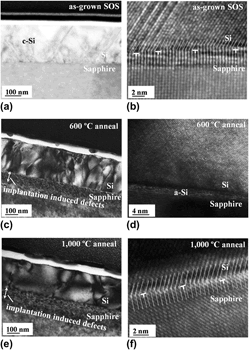Published online by Cambridge University Press: 14 May 2013

In the semiconductor industry, ion implantation and the subsequent annealing have ubiquitously been used to mitigate residual stresses and crystallographic defects in a film-on-substrate system. However, the relationship between crystal quality and residual stresses induced by lattice mismatch and disparate thermal expansions has not yet been understood. This paper aims to clarify the mist through an in-depth investigation into the stress and microstructure variations in the ion implantation and annealing processes. It was found that a higher-energy implantation with a higher ion dose density leads to a more significant relief of residual stresses. However, a higher annealing temperature, which results in fewer defects, will bring about greater residual stress regeneration. To achieve a higher crystal quality but lower stresses, it is necessary to enable the ions to penetrate through the film to cause substrate expansion, such that the mismatch between the film and substrate is mitigated and the high temperature annealing can be utilized to minimize the interface defects.